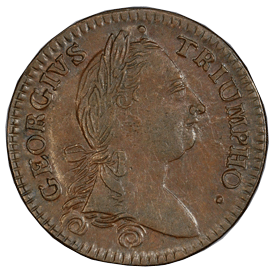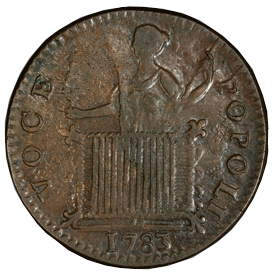SYMBOLS
Triumphant George Token
Move your cursor over the coin or tap it on your screen to see the reverse side.


- These early U.S. coins are of British origin, most likely from Birmingham, England. They were designed to commemorate the end of the American Revolution. Some sources indicate that the head of the coin was intended to be either King George III or General George Washington. The laurel-wreathed George was in the style of King George III's Irish halfpenny image.
- Historians believe these coins, circulated during the period of the Confederation in Georgia and Virginia, were intended to display patriotism and signify the new states' unity.
- The coins were generally struck later than the dates shown on the coins. Some were struck after 1815 and circulated in the United States well into the mid-1800s.
- The reverse of the coin features an allegorical female figure who perhaps represents Liberty but is similar to Britannia. The figure holds an olive branch in her right hand and a staff in her left. If it is intended to represent Britannia, she would be holding a trident. Liberty's staff traditionally includes a cap on top of her staff. The female figure represented on this coin stands behinds 13 columns with a fleur-de-lis, a traditional French symbol, in each corner. This symbolized the 13 united colonies and the French financial support that contributed to the colonists' victory in the American Revolution. The motto, Voce Popoli, translates to "By the Voice of the People."